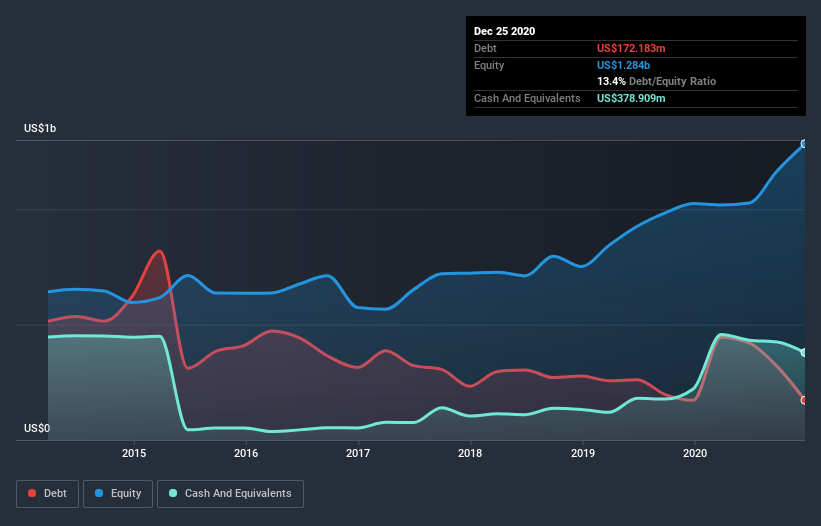Graco (NYSE:GGG) Seems To Use Debt Rather Sparingly
Warren Buffett famously said, 'Volatility is far from synonymous with risk.' When we think about how risky a company is, we always like to look at its use of debt, since debt overload can lead to ruin. We can see that Graco Inc. (NYSE:GGG) does use debt in its business. But should shareholders be worried about its use of debt?
When Is Debt A Problem?
Generally speaking, debt only becomes a real problem when a company can't easily pay it off, either by raising capital or with its own cash flow. Ultimately, if the company can't fulfill its legal obligations to repay debt, shareholders could walk away with nothing. While that is not too common, we often do see indebted companies permanently diluting shareholders because lenders force them to raise capital at a distressed price. By replacing dilution, though, debt can be an extremely good tool for businesses that need capital to invest in growth at high rates of return. When we examine debt levels, we first consider both cash and debt levels, together.
Check out our latest analysis for Graco
What Is Graco's Debt?
The image below, which you can click on for greater detail, shows that Graco had debt of US$163.0m at the end of December 2020, a reduction from US$172.0m over a year. However, it does have US$378.9m in cash offsetting this, leading to net cash of US$215.9m.
A Look At Graco's Liabilities
We can see from the most recent balance sheet that Graco had liabilities of US$321.4m falling due within a year, and liabilities of US$382.8m due beyond that. On the other hand, it had cash of US$378.9m and US$314.9m worth of receivables due within a year. So these liquid assets roughly match the total liabilities.
Having regard to Graco's size, it seems that its liquid assets are well balanced with its total liabilities. So while it's hard to imagine that the US$11.8b company is struggling for cash, we still think it's worth monitoring its balance sheet. While it does have liabilities worth noting, Graco also has more cash than debt, so we're pretty confident it can manage its debt safely.
Graco's EBIT was pretty flat over the last year, but that shouldn't be an issue given the it doesn't have a lot of debt. When analysing debt levels, the balance sheet is the obvious place to start. But ultimately the future profitability of the business will decide if Graco can strengthen its balance sheet over time. So if you're focused on the future you can check out this free report showing analyst profit forecasts.
Finally, a company can only pay off debt with cold hard cash, not accounting profits. Graco may have net cash on the balance sheet, but it is still interesting to look at how well the business converts its earnings before interest and tax (EBIT) to free cash flow, because that will influence both its need for, and its capacity to manage debt. Over the most recent three years, Graco recorded free cash flow worth 73% of its EBIT, which is around normal, given free cash flow excludes interest and tax. This free cash flow puts the company in a good position to pay down debt, when appropriate.
Summing up
While it is always sensible to look at a company's total liabilities, it is very reassuring that Graco has US$215.9m in net cash. The cherry on top was that in converted 73% of that EBIT to free cash flow, bringing in US$323m. So is Graco's debt a risk? It doesn't seem so to us. Another factor that would give us confidence in Graco would be if insiders have been buying shares: if you're conscious of that signal too, you can find out instantly by clicking this link.
Of course, if you're the type of investor who prefers buying stocks without the burden of debt, then don't hesitate to discover our exclusive list of net cash growth stocks, today.
This article by Simply Wall St is general in nature. It does not constitute a recommendation to buy or sell any stock, and does not take account of your objectives, or your financial situation. We aim to bring you long-term focused analysis driven by fundamental data. Note that our analysis may not factor in the latest price-sensitive company announcements or qualitative material. Simply Wall St has no position in any stocks mentioned.
Have feedback on this article? Concerned about the content? Get in touch with us directly. Alternatively, email editorial-team (at) simplywallst.com.

 Yahoo Finance
Yahoo Finance 
